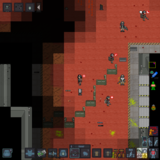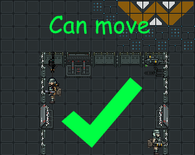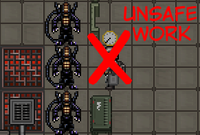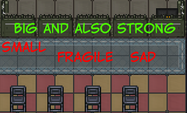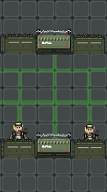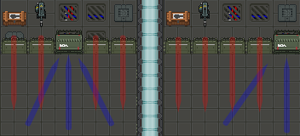More actions
(Rank Variation) |
mNo edit summary |
||
| (4 intermediate revisions by 4 users not shown) | |||
| Line 7: | Line 7: | ||
|jobtitle = Combat Technician [[File:Squad_engineer_icon.png]] | |jobtitle = Combat Technician [[File:Squad_engineer_icon.png]] | ||
|difficulty = Medium | |difficulty = Medium | ||
|rank = Private First Class / Lance Corporal / Corporal | |rank = Private First Class [Under 10hrs] / Lance Corporal [10hrs] / Corporal [70hrs] | ||
|superior = [[Squad Leader]] | |superior = [[Squad Leader]] | ||
|unlock = One hour as any squad role. | |unlock = One hour as any squad role. | ||
| Line 743: | Line 743: | ||
== In the field == | == In the field == | ||
=== Power and T-Comms === | === Power and T-Comms === | ||
Upon the first deployment, you are likely to be tasked to either [[Guide_to_Engineering#Power_Duty|fixing the Power]], [[Guide_to_Engineering# | Upon the first deployment, you are likely to be tasked to either [[Guide_to_Engineering#Power_Duty|fixing the Power]], [[Guide_to_Engineering#Static_Telecommunications|fixing the Telecommunications Tower]] or FOB duty. | ||
<br> | <br> | ||
| Line 1,031: | Line 1,031: | ||
|- | |- | ||
|[[File:Metal_Barricade.png|64px]]<br>'''Metal Barricade''' | |[[File:Metal_Barricade.png|64px]]<br>'''Metal Barricade''' | ||
| | |4 Metal[[File:Metal.png]] | ||
|The most common among the three main types of barricades (20 points for 50 sheets). Can be repaired with a blowtorch if not overtly damaged. | |The most common among the three main types of barricades (20 points for 50 sheets). Can be repaired with a blowtorch if not overtly damaged. | ||
'''To unsecure:''' [[File:Screwdriver.png|32px]] -> [[File:Wrench.png|32px]] (To secure: [[File:Wrench.png|32px]] -> [[File:Screwdriver.png|32px]]) | '''To unsecure:''' [[File:Screwdriver.png|32px]] -> [[File:Wrench.png|32px]] (To secure: [[File:Wrench.png|32px]] -> [[File:Screwdriver.png|32px]]) | ||
| Line 1,086: | Line 1,086: | ||
|vehicles=1 | |vehicles=1 | ||
|jtac=1 | |jtac=1 | ||
|fireman=1 | |||
}} | }} | ||
Latest revision as of 09:46, 6 December 2024
 |
Difficulty: Medium Supervisors: Squad Leader Rank: Private First Class [Under 10hrs] / Lance Corporal [10hrs] / Corporal [70hrs] Duties: Set up defenses, babysit big guns, open doors and spam barbed wire. Guides: Construction, Guide to Engineering Unlock Requirements: One hour as any squad role. Detailed Description: You have the equipment and skill to build fortifications, reroute power lines, and bunker down. Your squaddies will look to you when it comes to construction in the field of battle. |__________| |
But the good news — we got four of these robot sentries with display and scanners intact. They really kick ass, I think they'll come in handy.
―Corporal Hicks, Aliens
As a Combat Technician, your main goals will be fixing power, getting through doors, and setting up fortifications for a FOB (Forward Operating Base) that'll be used for defense and to secure a supply route. Without you, your platoon will have no power or a FOB which is critical for mission success.
Combat Technician
You'll have two different playstyles you can experiment with. One, as a FOB building and Utility Technician, who sets up defences and makes sure power is running. The second way to play technician is to be a Combat Technician, breaching walls, hacking open doors, welding vents and repairing broken APC and lights as marines advance. Both are as good as the other, but too much of one is bad. Make sure there is a FOB that will be able to be defended, and if there is one, make sure marines will be able to make it from building to building effectively.
 Automated Closet
Automated Closet 
| Armor: | Description: | ||
|---|---|---|---|

M3-L Pattern Armor |
A lighter, cut down version of the standard M3 pattern armor. It sacrifices protection for more speed. Protects more against acid.
| ||

M3 Pattern Marine Armor |
Standard Issue Armor used by USCM. Provides modest protection from bullet and melee attacks. It also has a shoulder-mounted directional flashlight for night time combat and a HUD to see their Marine roles. An all rounder in terms of protection with an additional 3 slots in the armor.
| ||

M3 EOD Pattern Heavy Armor |
A heavier version of the standard M3 pattern armor, the armor is primarily designed to withstand ballistic, explosive, and internal damage, with the drawback of increased bulk and thus reduced movement speed, alongside little additional protection from standard blunt force impacts and none from biological threats.
|
| Backpack: | Description: |
|---|---|

H5 Pattern M2132 Machete Scabbard |
A large leather scabbard used to carry an M2132 machete. It can be strapped to the back or the armor. |

Technician Backpack |
A standard-issue backpack worn by USCM technicians.
Has to be held in one hand to access items inside. Holds 7 normal size items. |

Technician Satchel |
A heavy duty chestrig used by some USCM technicians.
It is standard gear for most of the USCM. Holds 5 normal size items. |

L44 M37A2 Scabbard |
A large leather holster allowing the storage of an M37A2 Shotgun. It contains harnesses that allow it to be secured to the back for easy storage. |

Technician Welderpack |
A specialized backpack worn by USCM technicians. It carries a fuel tank for quick welder refuelling and use.
Has to be held in one hand to access items inside. Holds 7 normal size items and 260 units of welder fuel. |

Technician Welder-Satchel |
A specialized satchel worn by USCM technicians and engineers. It carries two small fuel tanks for quick welder refueling and use.
Holds 4 normal sized items. Contains 100 units of fuel. |
| Belt: | Description: |
|---|---|
 G8-A General Utility Pouch |
A small, lightweight pouch that can be clipped onto Armat Systems M3 Pattern armor to provide additional storage. The newer G8-A model, while uncomfortable, can also be clipped around the waist. Can hold more varied items than the standard belts. It is one of the rarer pouches inside the ColMarTech automated armaments vendor in Requisitions. They can hold 3 items. |
 M276 Pattern Ammo Load Rig |
The M276 is the standard load-bearing equipment of the USCM. It consists of a modular belt with various clips. This version is the standard variant designed for bulk ammunition-carrying operations. Holds 5 various magazines. |
 M276 Pattern General Pistol Holster Rig |
The M276 is the standard load-bearing equipment of the USCM. It consists of a modular belt with various clips. This version has a holster assembly that allows one to carry the M4A3, 88M4, or the M1911 comfortably secure. It also contains side pouches that can store 9mm or .45 magazines.
It is one of the uncommon rigs inside USCM Vendors. It is also the standard rig for Cargo Technicians, Intelligence Officers, Pilot Officers, Staff Officers, and the Executive Officer. |
 M276 Pattern M39 Holster Rig |
The M276 is the standard load-bearing equipment of the USCM. It consists of a modular belt with various clips. This version is designed for the M39 SMG and features a larger frame to support the gun. Due to its unorthodox design, it isn't a very common sight and is only specially issued. |
 M276 Pattern M44 Holster Rig |
The M276 is the standard load-bearing equipment of the USCM. It consists of a modular belt with various clips. This version is for the M44 magnum revolver, along with three pouches for speedloaders. It faintly smells of hay. |
 M276 Pattern M82F Holster Rig |
The M276 is the standard load-bearing equipment of the USCM. It consists of a modular belt with various clips. This version is for the M82F flare gun. |
 Shotgun Shell Load Rig |
An ammunition belt designed to hold shotgun shells or individual bullets. Holds 10 handfuls of shells. |
 M276 pattern mortar operator belt |
A belt specifically designed to carry ammunition for the M402 mortar along with a sidearm.
Holds 4 mortar shells of any kind and reserves a slot for a pistol. |
 M276 Pattern M40 Grenade Rig |
The M276 is the standard load-bearing equipment of the USCM. It consists of a modular belt with various clips. This version is designed to carry bulk quantities of M40 series of Grenades.
It is the standard rig for Frontline Grenadier Kits. |
 M276 Pattern Toolbelt Rig |
The M276 is the standard load-bearing equipment of the USCM. It consists of a modular belt with various clips. This version lacks any combat functionality and is commonly used by technicians to transport important tools. This contains all the tools for the Combat Technicians and Maintenance Technicians to do their work. |
| Pouch: | Description: | ||||
|---|---|---|---|---|---|
 Construction Pouch |
Designed to holster construction materials. | ||||
 First-Aid Pouch(Refillable Injectors) |
Standard issue field aid for all soldiers. Comes pre-loaded with basic medical supplies. Expended autoinjectors can be restocked at a medical vendor on the Almayer and Dropships (sometimes NanoMed machines are functional planetside.) It is one of the pouch options of the ColMarTech Automated Closet.
It contains the following:
| ||||
 First-Aid Pouch(Splints, Gauze, Ointment) |
Standard issue field aid for all soldiers. Comes pre-loaded with basic medical supplies. Expended autoinjectors can be restocked at a NanoMed
| ||||
 First-Aid Pouch(Pill Packets) |
Standard issue field aid for all soldiers. Comes pre-loaded with basic medical supplies. Comes with two packets of 4 pills. One containing Tricordazine and the other with Tramadol. It is one of the pouch options of the ColMarTech Automated Closet.
It contains the following:
| ||||
 Electronics Pouch (Full) |
Designed to hold all your electronic needs as a technician. Issued to Combat technicians, or found inside the ColMarTech automated armaments vendor in Requisitions.
Contains 6 slots. | ||||
 Explosive Pouch |
Container designed to hold up to three grenades or other explosives | ||||
 Flare Pouch |
Can hold 8 flares (including activated flare). Refillable with a M94 Flare Pack. | ||||
 Large Pistol Magazine Pouch |
Pouch able to hold pistol magazines. | ||||
 Magazine Pouch |
Uncommon issue pouch that can hold three magazines and/or handfuls of shotgun shells. Issued to Medics and Engineers. It is also one of the pouch options of the ColMarTech Automated Closet and is found in the ColMarTech automated armaments vendor in Requisitions. Contains 3 slots. | ||||
 Shotgun Shell Pouch |
A shotgun shell pouch. It can contain handfuls of shells, or bullets if you choose to for some reason. Holds 5 slots. | ||||
 Medium General Pouch |
A general purpose pouch used to carry more small items and also magazines. Contains 2 slots. | ||||
 Pistol Pouch |
A holster to carry pistols, typically a standard issue M4A3 handgun, or 88M4 Pistol. | ||||
 Tools Pouch (Full) |
Designed to hold all your different types of tools. |
| Accessories: | Description: |
|---|---|

Shoulder Holster |
A traditional shoulder holster that can be attached to all uniforms. Can holster any handgun and completes the look of any hard-boiled detective. |
 Webbing |
Sturdy mess of synthcotton belts and buckles, ready to share your burden. Holds 3 small sized items or magazines. |
 Brown Webbing Vest |
Worn brownish synthcotton vest with lots of small pockets to unburden your hands. Holds 5 small sized items. |
 Black Webbing Vest |
Robust black synthcotton vest with lots of pockets to hold whatever you need, but cannot hold in hands. Holds 5 small sized items. |
 Drop Pouch |
A convenient pouch to carry loose items around. Able to hold 2 large items. |
| Mask: | Description: |
|---|---|
 Gas Mask |
Gas masks are available in ColMarTech Automated Closets for all marines. Does not protect the head in anyway. |
 Heat Absorbent Coif |
A close-fitting cap that covers the top, back, and sides of the head. Can also be adjusted to cover the lower part of the face so it keeps the user warm in harsh conditions.
Part of the marine uniform on snow planets. |
 Automated Equipment Rack
Automated Equipment Rack 
Each Equipment Rack starts with 45 points for you to spend on additional items for your deployment. These are all listed below.
|
Equipment and Gear
Metal and Sandbags
At round start, there are 30 plasteel sheets and 50 metal sheets in your essential technician kit. Plasteel is an expensive but very resistant material at your disposal. More can be purchased at your equipment closet or as supplies start trickling in through the ASRS, you may be able to acquire more. Don't hoard loads of building supplies otherwise you might find fellow Combat Technicians unable to perform their jobs, and if you are captured or die with a lot of supplies, they will likely be gone from the round.
Linking Plasteel Barricades 
You can link plasteel barricades together with a crowbar. This is can used for making a gate for more marines to fit through. It requires at least 2 plasteel barricades facing the same direction and same state (Open/Closed) in order for it to work. Sometimes barricades may be moved or repositioned, and the person doing it may wrench them in place but forget to close the protective cover with their screwdriver. If you ever use your crowbar on a plasteel barricade and do not get the prompt that the barricade is ready for linking, check with your screwdriver (or Shift+Click to examine).
In the field
Power and T-Comms
Upon the first deployment, you are likely to be tasked to either fixing the Power, fixing the Telecommunications Tower or FOB duty.
Overcoming obstacles
 Use a crowbar to pry open powered down doors.
Use a crowbar to pry open powered down doors.- Hack doors to open previously locked passageways. If a door is not powered, but is bolted (Solid yellow lights on the door), you will have to restore power to the door before it will open.
 C4 doors/walls if you don't have time to hack/deconstruct.
C4 doors/walls if you don't have time to hack/deconstruct.- Disassembling windows (
 ->
-> ->
-> ) and window frames (
) and window frames ( )
)
Lighting up the place
- Fix the APC's and replace broken lights with the light replacer along the way as you advance.+
- Fixing lights is (in my opinion) one of the most powerful tools the combat technician has at his disposal. Without lights, anybody passing between the front line and the landing zone is walking through dark passages, and most of the time the people doing this are medics with a wounded ally.
Floodlight Repair
While you may have fixed the power for the colony (and turned on the Colony Floodlight Switch ![]() ), the aliens will have most likely broken floodlights around the place which you'll need to fix. To fix a floodlight you'll want to use the following steps:
), the aliens will have most likely broken floodlights around the place which you'll need to fix. To fix a floodlight you'll want to use the following steps:
- Emergency Floodlights can be unwrenched and be moved around.
 Deploying your defensive structure
Deploying your defensive structure 
When you hit the field, you'll be needing to place your defensive structure down in order to have it either man the flanks or aid the marines in combat.
Simply take the defensive structure in your hand and click on it while it's in your active hand. Make sure the tile in front of you is empty and clear. Once deployed, make sure you click on the defensive structure again to turn it on, and lock it via the right-click menu or a verb in the "Object" tab if you want to prevent non-technicians turning it off. You can easily pick it up with a Security Access Tuner ![]() as long as it is in pristine condition. If it has been damaged, simply use a welder to repair it. You can also unanchor it to move it around without needing to pick it back up again with a Wrench
as long as it is in pristine condition. If it has been damaged, simply use a welder to repair it. You can also unanchor it to move it around without needing to pick it back up again with a Wrench ![]() .
.
 Using the Sentry Laptop
Using the Sentry Laptop
Once you've deployed your sentry of choice, you may also set up a sentry laptop - available from Requisitions or your preparation room, alongside unique encryption keys. To connect it to your sentry, use your Security Access Tuner ![]() on the laptop, then click on the sentry gun with the same Security Access Tuner to connect it. Multiple sentries can be connected to the same laptop.
on the laptop, then click on the sentry gun with the same Security Access Tuner to connect it. Multiple sentries can be connected to the same laptop.
When deployed and interacted with after linking, you may toggle the IFF settings of the sentry to control who it will NOT fire upon, ranging from avoiding USCMC + WY personnel, USCMC personnel, or all humanoids, and you may use it as a camera with the same view range as a human. Additionally, when engaging a target, the sentry will send a report over a radio, which you can hear using the unique encryption keys that come with it.
Make use of vendors
 Use a wrench to move useful vendors like medical vendor to a FOB then hack
Use a wrench to move useful vendors like medical vendor to a FOB then hack  them to allow medics and marines to vendor the items.
them to allow medics and marines to vendor the items.
Securing flanks/supply route
It's crucial to secure the supply route from FOB to the front. Otherwise, reinforcements, Medics, and wounded marines will be easy targets to be picked off and the front will risk being cut off and encircled. Since material supply might be limited under certain circumstance so you can't barricade all the way; instead, you need to focus on the choke points like doorways, to secure as many sections you can with the little materials you have. You can save some materials by simply welding doors shut along the way. And once marines have learned that can Xenos use vents, you can weld the vents shut to deny their usage. You can also use vendors/cabinets as blockades to save more materials but they can potentially block bullets as well, resulting in a potential cover for aliens.
Your flanks are a vital part of your frontlines, FOBs and supply lines.
The enemy will always try to find a way to breach your vulnerable locations and pick off your fellow team mates.
If you think they can breach into your vulnerable flanks or supply lines, secure it.
In the Front
This is where the combat technician shines and determines whether or not the marines will gain a foothold or be routed after their initial push. There are three main types of barricade lines you can build in the front, but there are some principles that apply to all.
- Build the barricades inward for more firing space and bigger kill zone
- Force the enemy into the choke point/corridor so fewer of them can attack at once (and block each other when they retreat)
- Distant the barricades to enemies' nearest corners/covers, thus exposing them with more firepower before they can reach the barricades and when they retreat
- Build the barricades with marines standing one tile behind in mind
| Barricade Layout: | Description: |
|---|---|

|
The original barricade line makes a small chokepoint which can't effectively utilise the full power of the marines in the area; to fix this the barricade defence could've been constructed on the red line to allow for additional marines to fire or even further back on the blue line to use the xenos cover against them and create a two tile chokepoint that will expose them to more gunfire, while also keeping the defending marines at a safe distance.
✔ Forces the enemy to walk past a choke, Exposing them to more fire on their attempted exit ✔ Two tiles from the enemies nearest position with cover. (Meaning they have to expose themselves to push) ✔ Marines standing one tile behind the barricaded position so they can't be slashed but can still hold the barricade itself. |

|
This is an example of what not to do when constructing a barricade position.
By having the barricades extend outwards it places the defending marines into the chokepoint giving them a disadvantage during combat. |

|
This is an example of what you should do when constructing a barricade position.
By having the barricades extend inwards it utilises the chokepoint making it harder for the xenos to push through. |
Frontline FOB/Outpost
A secured space slightly behind the front for marines to resupply, triage and casevac. Without a frontline FOB, Medics and the wounded will be harassed constantly and supply melted. And in the event of counterattack, marines will likely to be routed without a place to fall back to. Frontline FOB doesn't need to be big (a 6x6 space will do, bigger if high pop), otherwise, parts of the FOB likely be left unguarded and be melted.
Secured barricade line
Build at a choke point, apply the principles, and you get a decent defensive position. To reinforce a barricade line, build barricades one tile in front of the barricade line not behind.
Unsecured barricades
Mostly seen when you want to build a secured barricade line but ran out of plasteel, so you have to leave some gaps. While they are not fully secured, they are still useful to hinder counter attacks and block off Boiler gas and Crusher charge. To avoid hindering marines' push, you can build them in the middle of the corridor (e.g. middle 2 tiles out of 4 tiles), then the sides tiles in further one tile.
Barricade as marines push
Sandbags are particularly well suited for this job, as they can be built by marines and the build time is short. Metal barricades (with barbed wire) work too, though instead of standing in the front and build there, it's much safer to build it just behind the front then move them to the front (See this table for how to move barricades).
Robotic limbs repairing
Target the damaged limb while on assist intent and use:
FOB Duty
As a Combat Technician on FOB duty, you'll be setting up the base that the marines will primarily use to organize, resupply, to retreat to, and to make a final last stand. To make a good FOB, you'll want to make strategic use of your landmines, the smartgun HMG or the sentry gun, and various defensive emplacements. A good FOB is a difference between losing the round and holding off long enough to make a push back and finally win the round.
The Construction page will have everything you need to construct a FOB, from wooden barricades to plasteel barricades. It also includes many other helpful things for a combat technician to build around the FOB, or elsewhere.
Principles
You don't always need a mega FOB
LZ/FOB will only see poking most of the round until siege happens because FOB is a hard target. Thus, ambush xenos are likely to focus on marine's unsecured sections of the supply route. Focusing your effort solely on FOB means using a large amount of material to counter a token force while ignoring the threat targeting the more vulnerable areas. Instead, you need to secure flanks/supply route.
Barricade where enemy can't bypass
While Xeno will try to flank you, your job is to make them a hard time to do so. If you build barricades where they don't matter (not part of the supply route/no marine will be there), you will do Xenos a favour, as there will be fewer defences where it does matter.
It is the weakest point that matters
It doesn't matter there are three layers of barricades in Nexus if the one layer metal barricades at LZ is breached, the wounded and the supply will be killed and melted. Even worse, Xeno can ignore Nexus entirely and focus on LZ then everything in Nexus will be wasted.
Use materials wisely
Plasteel is expensive, $4,000 for 30 plasteel (3 doors) vs. $2,000 for 50 metal (8 barricades with barbed wire). Yet plasteel is crucial to how many secure spaces you can create. If you are out of plasteel, you are forced to keep an opening in the cade line, thus compromising the effect of the barricade line.
A corridor with traffic? A plasteel barricade with barbed wire. No traffic but a high threat (e.g., Crusher charge/constant poking)? Sandbags barricades with barbed wire. No traffic and want to keep Runners out? Metal barricades with barbed wire. And try to save materials by
 Use blowtorch on the vents/doors. (
Use blowtorch on the vents/doors. ( Flip down before you start.)
Flip down before you start.) Use wrench to move vendors/cabinets/hydro trays as blockades (hydro trays don't block Runner).
Use wrench to move vendors/cabinets/hydro trays as blockades (hydro trays don't block Runner).- Then build barricades behind them if it's high threat and if you can spare the supplies.
Putting cades close together isn't usually a good idea
Boilers can gas cades in either a 5x5 or 3x3 square, putting cades closer than 3 tiles together is asking for a trapper to shoot both at once. Ideally you always need a 3 tile gap - one tile of empty space for HMGs, one tile for defenders to stand on/sentries/combat technicians to weld from so that they can't get slashed, and another line behind that for people to move around in. This will also allow for a proper evacuation of the cadeline in case of boiler attack.
FOB Construction Quick Tips
Barricade Placement
| Barricade Placement | Description |
|---|---|
|
This is an example of what not to do when constructing a defensive position. In the picture on the left, you'll see that the aliens can hit the barricade without being shot due to its forward position and as such the alien will be able to break through and kill that marine with ease. | |
|
This is an example of what you should do when constructing a defensive position. To rectify the above barricade placement errors you'll want to move the barricades back one tile like the photo on the left. By moving the barricades back this will allow you to shoot aliens who are attacking them. |
Barbed Wire
![]() Barbed wire is a string of sharp metal that will harm and prevent xenos from pouncing over barricades once attached. It also gives a small health boost to the barricade itself.
Barbed wire is a string of sharp metal that will harm and prevent xenos from pouncing over barricades once attached. It also gives a small health boost to the barricade itself.
| Barbed Wire Tactics | Description |
|---|---|
| In the picture you'll see that the combat technician was killed due to the alien being able to pounce over the barricade. | |
|
Due to the combat technician placing barbed wire onto the barricades the alien was unable to jump over. |
FOB Space
| How To: Fob Space | Description |
|---|---|
|
This is an example of what not to do when constructing a defensive position. In the picture you'll see that the FOB has very little space for the marines to move around in which will lead to:
| |
|
This is an example of what you should do when constructing a defensive position. In the picture you'll see that the FOB has ample space to move which means:
|
Fixing Breaches in Defences
| Fixing Defensive Breaches | Description |
|---|---|
|
This is an example of what not to do when attempting to fix a breach in the defensive line with hostiles nearby. In the picture you'll see that this is a highly dangerous and ineffective way to fix the breach in a defensive line if hostiles are nearby. This will let you get slashed up by an alien running up willy nilly and will give you less time to react if multiple Aliens decide to push the defensive line. | |
|
This is an example of what to do when attempting to fix a breach in the defensive line with hostiles nearby. In the picture you'll see that it shows the optimal way of repairing a breach in your defenses if Aliens are nearby.
|
Misc. FOB tips
| Fob Tips | Description |
|---|---|
|
In the picture you'll see that it demonstrates that windows, even if reinforced, are not an acceptable replacement for a line of all-American steel barricades.
In summary, avoid using them as a defence. | |
| If you have a secured barricade line and you want to strengthen it, put the extra barricades in front of the secured barricade line not behind, and don't block the plasteel barricades. And if you can make a secured cade line, make one, checkerboard barricades do nothing to hinder the aliens' attack. | |
|
Barricades will end up damaged due to the ravages of war and incompetence, and if it isn't heavily damaged, you'll be able to use a blowtorch on it to repair it. This works on metal and plasteel barricades. Note that if a barricade is too damaged, you will be unable to fix it.
| |
|
Align the plasteel barricades to reduce traffic jam. | |
| Place the plasteel barricade at the side reduce the chance retreating marines blocking defensive fire. It also avoids two marines getting in the way of each other when both are exiting/entering. | |
|
Maze-like barricades serve no purpose as Xeno will not follow the corridor, they will slash them down with no regard yet marines will surfer traffic jam. Instead, align the exit with plasteel. |
Fortifications of the Trade
- Main article: Guide to Construction#Defences
| Fortification | Material | Function |
|---|---|---|
 Hand Rail |
2 Metal 
|
A handrail to ward off any intrusions into unwanted areas. Provides very little cover without reinforcing it. To reinforce the handrail, simply add 1 metal sheet to it and weld it.
To remove reinforced plate : |
 Snow Barricade |
3 Snow Piles
|
A very weak barricade constructed from snow piles with a snow shovel. It's better than thin air at least.
Deconstruct: |
 Wood Barricade |
10 Wooden Planks 
|
Used for a hasty defense against aliens. Mostly seen prespawned. Can be repaired with additional wooden planks at any damaged condition.
Deconstruct: Bash the wooden barricade to break it. Give back 3 wooden planks |
 Metal Barricade |
4 Metal
|
The most common among the three main types of barricades (20 points for 50 sheets). Can be repaired with a blowtorch if not overtly damaged.
To unsecure: To upgrade a barricade, click on one with 2 metal sheets, a window will prompt open in which you select the upgrade. |
 Metal Barricade Reinforced |
2 Metal
|
An upgraded version of the metal barricade. This one can take much more damage from bullets and slashes. Can be repaired with a blowtorch if not overtly damaged. |
 Metal Barricade Bio-hazard Resistant |
2 Metal
|
An upgraded version of the metal barricade. This one can take much more damage from acids and fire. Can be repaired with a blowtorch if not overtly damaged. |
 Metal Barricade Explosion Resistant |
2 Metal
|
An upgraded version of the metal barricade. This one can take much more damage from explosive sources with no downside. Can be repaired with a blowtorch if not overtly damaged. |
 Sandbags |
5 Sandbags
|
Dig up dirt with an entrenching tool to fill up the empty sandbags. A fast fortification to field and can built by any marines. You can construct a sandbag barricade with any amount (maximum of 5) from a stack. The more you have in a stack, the stronger it becomes but if you deploy a sandbag with less than the maximum, the weaker the sandbag's maximum health will be. More sandbags can be added to a weaker one until it reaches full strength. Relatively cheap (20 points for 50 empty sandbags). Can be repaired by using filled sandbags.
Deconstruct: |
 Plasteel Barricade |
8 Plasteel
|
Functions as a gate. The most durable fortification with longest build time. The most expensive barricade (40 points for 30 sheets). Can be repaired with a blowtorch if not overtly damaged. |
 Folding Metal Barricade |
6 Metal
|
A folding barricade made out of metal, making it slightly weaker than a normal metal barricade. Use a blowtorch to repair. Can be flipped down to create a path. |
 Barbed Wire |
1 Metal
|
Can be added to barricades prevent them from being pounced and climbed over. Damages mobs that melee attack without a weapon. Deconstruct: |
 Wall |
12 Metal 
|
Used to fully block off an area. See Guide to construction for how to construct and deconstruct. |
Your Skillset
|
| ||||||||||||||||||||||||||||||||||||||||||||||||||||||
|
| ||||||||||||||||||||||||||||||||||||||||||||||||||||||
|
|
To find out about how the skill system works head over to the skills system page.
Guides
- Guide To Engineer by Stan_albatross on 08 Aug 2021, updated on 14 Nov 2021
- On FOB Duty by RNGPriest on 07 Nov 2019
- A couple tactically sensible 'cade layout tips by FreeStylaLT on 25 Feb 2018
- The Field Engineer Commandments by Surrealistik on 01 Oct 2017, updated 07 Aug 2018
- [WIP] Useful FOB engineering 101 by Challenger on 22 Jul 2017


























































































